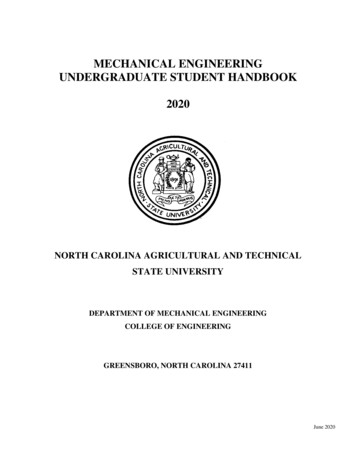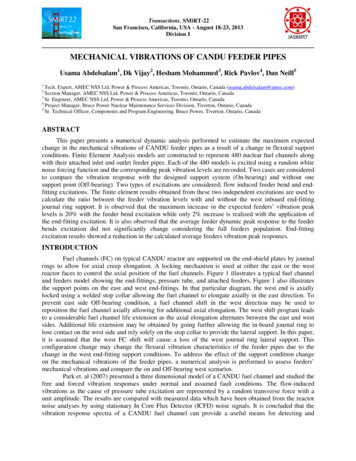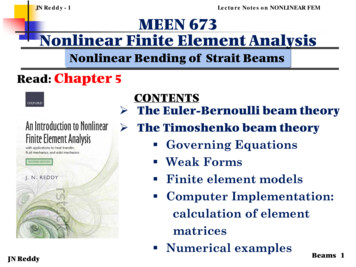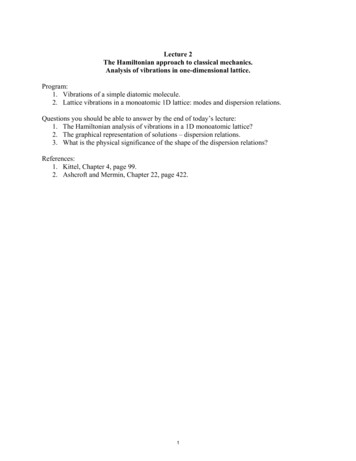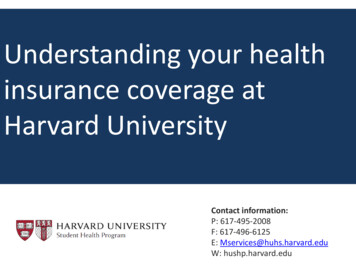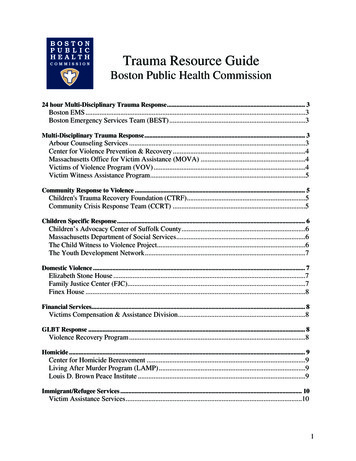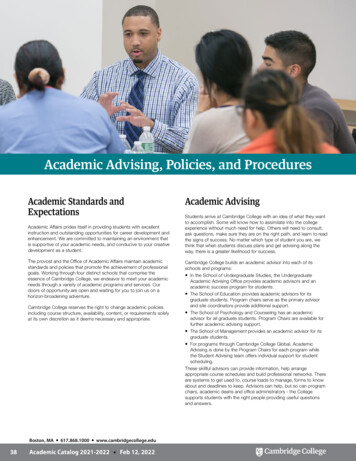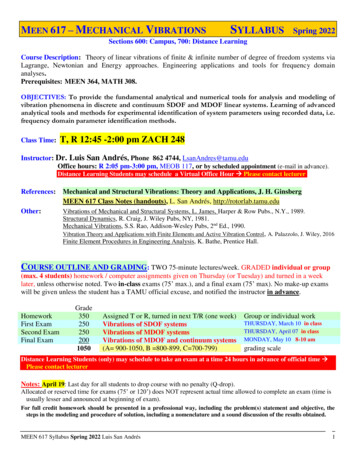
Transcription
MEEN 617 – MECHANICAL VIBRATIONSSYLLABUSSpring 2022Sections 600: Campus, 700: Distance LearningCourse Description: Theory of linear vibrations of finite & infinite number of degree of freedom systems viaLagrange, Newtonian and Energy approaches. Engineering applications and tools for frequency domainanalyses.Prerequisites: MEEN 364, MATH 308.OBJECTIVES: To provide the fundamental analytical and numerical tools for analysis and modeling ofvibration phenomena in discrete and continuum SDOF and MDOF linear systems. Learning of advancedanalytical tools and methods for experimental identification of system parameters using recorded data, i.e.frequency domain parameter identification methods.DRAFTT, R 12:45 -2:00 pm ZACH 248Class Time:Instructor: Dr. Luis San Andrés, Phone 862 4744, LsanAndres@tamu.eduOffice hours: R 2:05 pm-3:00 pm, MEOB 117, or by scheduled appointment (e-mail in advance).Distance Learning Students may schedule a Virtual Office Hour Please contact lecturerReferences:Mechanical and Structural Vibrations: Theory and Applications, J. H. GinsbergMEEN 617 Class Notes (handouts), L. San Andrés, http://rotorlab.tamu.eduOther:Vibrations of Mechanical and Structural Systems, L. James, Harper & Row Pubs., N.Y., 1989.Structural Dynamics, R. Craig, J. Wiley Pubs, NY, 1981.Mechanical Vibrations, S.S. Rao, Addison-Wesley Pubs, 2nd Ed., 1990.Vibration Theory and Applications with Finite Elements and Active Vibration Control , A. Palazzolo, J. Wiley, 2016Finite Element Procedures in Engineering Analysis, K. Bathe, Prentice Hall.COURSE OUTLINE AND GRADING: TWO 75-minute lectures/week. GRADED individual or group(max. 4 students) homework / computer assignments given on Thursday (or Tuesday) and turned in a weeklater, unless otherwise noted. Two in-class exams (75’ max.), and a final exam (75’ max). No make-up examswill be given unless the student has a TAMU official excuse, and notified the instructor in advance.HomeworkFirst ExamSecond ExamFinal ExamGrade3502502502001050Assigned T or R, turned in next T/R (one week)Vibrations of SDOF systemsVibrations of MDOF systemsVibrations of MDOF and continuum systems(A 900-1050, B 800-899, C 700-799)Group or individual workTHURSDAY, March 10 in classTHURSDAY, April 07 in classMONDAY, May 10 8-10 amgrading scaleDistance Learning Students (only) may schedule to take an exam at a time 24 hours in advance of official time Please contact lecturerNotes: April 19: Last day for all students to drop course with no penalty (Q-drop).Allocated or reserved time for exams (75’ or 120’) does NOT represent actual time allowed to complete an exam (time isusually lesser and announced at beginning of exam).For full credit homework should be presented in a professional way, including the problem(s) statement and objective, thesteps in the modeling and procedure of solution, including a nomenclature and a sound discussion of the results obtained.MEEN 617 Syllabus Spring 2022 Luis San Andrés1
The instructor may make available (post) solutions to homework problems in MATHCAD. Students may work assignmentsusing any type of computational software. However, learning MATHCAD or MATHLAB should prove beneficial in youreducation.Spring 2022MEEN 617: CONTENT AND OUTCOMESJ. Mike Walker’66 Department of Mechanical Engineering, Texas A&M UniversityKey: G: X.Y: Ginsberg: 003/29111204/0504/0704/121304/191404/26Last classApril 281505/10HD: Dr. San Andrés handout notes & appendicesLecture Material (subject to revision)Introduction Importance of system dynamics analysis and design.Physical modeling of mechanical systems: equivalent stiffness, inertia and dampingelements, and associated energies. Linearization. Example of derivation of equation ofmotion for SDOF systems. The choice of a coordinate system.Mathematical modeling of mechanical systems. Derivation of SDOF equations usingNewton’s Laws. Equivalence of principle of linear & angular momentum andconservation of mechanical energy power balance for time-invariant systems.Dynamic free response of SDOF systems with viscous damping and dry-friction. Theconcept of natural frequency and damping ratio. Undamped systems and implications invibratory systems.Forced response of SDOF systems to impulsive and step forces.Dynamic forced response of SDOF systems to periodic loading. The complexfrequency response (amplitude and phase). Periodic forced response to imbalance load.Interpretation of forces in the regimes of operation.Force transmissibility to foundation. Forced response to ground motionUses of frequency response function to design mechanical systems.Forced response to an arbitrary periodic force excitation. Response to a unitimpulse. The convolution integral and response to arbitrary loadingInstrumentation for vibration measurement. Use Apps!DFTs and vibrations. The discrete Fourier transform and its applications.Experimental identification of parameters in simple mechanical systems.Analytical dynamics. The principles of virtual work and the Hamiltonian. Lagrange’sequations of motion.Analytical dynamics. Examples of deriving EOMs using Lagrangian MechanicsModal analysis of undamped MDOF systems. The concept of eigenvalues and modeshapes. Properties of orthogonal modes.Undamped modal free and force responses. Rayleigh and Rayleigh-Ritz Energymethods for estimation of natural frequencies.Reading AssignmentIntro, HD#1 (selfstudy)G: 1.1-.3App. BApps. A&DG: 1.4-.5HD # 2a,G: 2.2-.3HD #2b,G 3.1-.6HD #2cApp. FHD #2dApp. EHD #3HD # 4, G: 3.7-.8App AG: 1.5 G: 4.1HD #7, G: 4.2EXAM I Thursday March 08Spring Break March 14-18Eigenvalue problems: Numerical methods of solution (self-study)Application: The dynamic vibration absorber: design considerationsNumerical response of non-linear SDOF systemsModal analysis of MDOF systems with proportional dampingModal analysis of MDOF systems with Viscous Damping. State-space equations,modal coordinates and orthogonality properties, relations to undamped modes method.Direct periodic forced response of MDOF systems.HD # 9HD #10HD #6 G: 4.3HD # 8, G: 5.1-4HD # 11, G:10.110.5addendumEXAM II Thursday April 07Analysis of Continuum systems. Free vibrations of elastic bars and beams. Propertiesof normal mode functions. Forced response. The slinky challenge.Finite Element Method in vibrations. Fundamentals and FEM matrices for bars andbeams. Assembly and solution of global system of Eqns. Simple applications.Identification of parameters in mechanical systems Time and frequency domainmethods. Curve fits to impedances and the instrumental variable filter method.Direct numerical integration to find the response of MDOF systems. Stabilityanalysis and minimum time step. Average acceleration methodHD # 14. G: 7.1-7HD # 12 G: 8.1-.4HD # 15,G: 5.4. 1-2HD # 13FINAL Exam Monday May 10: 8-10 amMEEN 617 Syllabus Spring 2022 Luis San Andrés2
Ginsberg’s Vibrations textbook is an excellent resource to learn about the modern theory of vibrations. The book includes analysisusing discrete Fourier transforms, their implementation in commercial software (MATHCAD and MATHLAB), and a sound methodto identify system parameters from vibration test data in the frequency domain. The assigned reading material for each week seemsexcessive at first; however, I assure you that you will gain fundamental knowledge that cannot be found in any other textbook.MEEN 617 - MECHANICALVIBRATIONS. - Dr. Luis San AndrésPOLICIESThe lectures will broaden the coverage of the textbook and provide examples of analysis as applied to the modeling,analysis and interpretation of the dynamic response of linear mechanical systems. There will be significant amounts ofsubject material mentioned in the lectures that are not in the textbook. The textbook is not a complete reference for thiscourse.The class notes of Dr. Luis San Andrés are available at the URL http://rotorlab.tamu.edu. Attendance to the lectures is amust for success. References for outside reading to be recommended in class.The university views class attendance and participation as an individual student responsibility. Students are expected toattend class and to complete all assignments.Please refer to Student Rule 7 (http://student-rules.tamu.edu/rule07 ) in its entirety for information about excusedabsences, including definitions, and related documentation and timelines.ABOUT HANDOUTS AND TEXTBOOK: The handouts and textbook used in this course are copyrighted. By“handouts,” I mean all materials generated for the course, which include but are not limited to syllabi, quizzes, exams,worked problems, in-class materials and MATHCAD codes, review sheets, and additional problem sets. Because thecourse material is copyrighted, you do not have the right to distribute it, unless the author expressly grants permission.HOMEWORK:will be assigned on Tuesday (Thursday) and turned in on the following Tuesday (Thursday).Homework will be worked individually or in groups of up to FOUR students. Homework will be graded and returnedin class the following week. Homework makes 35% (350 points) of your total grade. There will be no excuses formissing homework or computer assignments.Distance Learning Students will be paired with Campus students to collaborate on the completion of assignments Please contact lecturerHomework material encompasses solving assigned specific problems (textbook and other resources),completing computational analyses to model simple structural systems (write computer programs ormodifying codes given to you in class), and performing measurements in simple systems.Complete solutions to HOMEWORK problems will NOT be posted. Partial solutions, i.e. answers, MAY be released.Students should take advantage of office hours to obtain help in developing clear procedures for solution of problems andto improve their understanding of class materials. The instructor will not solve problems for you during office hours;instead he will aid you learn an engineering method for problem solving.AW:BOUT RITING When developing a solution to homework problems, and in particular when developingsolutions to exam problems, students must write (in English) the complete development in full sentences, with stateddefinitions of parameters and description of procedures and used physical principles. A large portion or your grade(30% or more) will be given to presentation (writing: syntax and semantics). It is NOT enough to just state formulas andan answer.In other words, a full grade will be given for complete solutions that include written description of procedural steps toachieve task(s) and assumptions [full sentences, jargon-free], mathematical statements for calculations, and correctMEEN 617 Syllabus Spring 2022 Luis San Andrés3
magnitudes of results with appropriate physical magnitudes. There will be NO partial credit for mishandling of physicalunits. ME graduate students should be able to gauge the order of magnitude and correct physical magnitude of theproblem at hand.PRACTICE EXERCISES recommended as the semester progresses. The textbook contains numerous exercisesdemonstrating particular concepts of interest. The practice exercises are not graded, but they are good practice for theexams. Please learn by heart that the way to learn how to work problems is to work problems. Use the given answer (oddnumbered problems only) to determine that your strategy, solution procedure, and numerical computations are correct.Working backwards from the answer will not teach you the engineering method, or the principles involved to solve theproblem.Recommended problems (practice exercises) from your textbook (Ginsberg)weekchapterProblem numbers115, 8, 13, 14, 15, 20, 43, 44, 562217, 19, 21, 29, 31, 33, 39, 51, 57, 613&433, 7, 19, 20, 22, 25, 50, 5251Derive EOMs MODF systems: 25, 27, 30, 33, 36, 38, 39, 44, 496410,19, 21, 30, 36, 39,34, 557514, 18, 29873, 11, 43, 491063, 9, 11, 14, 15, 28, 38, 54More recommended problems to follow .Solutions to practice problems NOT posted. I urge students, taking advantage of office hours, to seek help indeveloping clear procedures for solution of problems and to improve their understanding of class materials. The instructorwill not solve problems for you in office hours; instead, he will help you learn an engineering method for problemsolving.ABOUT OFFICE HOURS: The purpose of office hours is to encourage individual interaction between thestudents and the instructor. The instructor is available to discuss not only questions related to the course, but other issueswhere he can help as a professional engineer, educator and researcher. Please take advantage of office hours. To utilizethis time efficiently, students should prepare by organizing questions in advance.I am willing to help you at times other than office hours without an appointment. However, just like you, I haveresponsibilities other than MEEN 617 (teach other classes, direct graduate student research, write proposals and technicalpapers; organize laboratories, voluntary work for ASME, etc.). I must budget certain times to meet those responsibilities.Please do not be offended if I am in the office but cannot meet with you outside of designated office hours.The use of e-mail for communication with your instructor is acceptable. I usually receive three types of e-mail messages:a) a request to schedule a meeting at other times than office hours,b) questions related to the impending take-home quiz due (say) next day,c) questions related to the study material for an exam.I reply promptly to all messages (usually the same day if I am in town).If you cannot find me in my Campus Office, please call me at 862 4744. I spend 50 hours/week at the TurbomachineryLaboratory (TL: corner of FM2818 and George Bush Dr). At the TL, I conduct research and manage a team of engineersperforming experimental and computational work serving the needs of industrial sponsors.MEEN 617 Syllabus Spring 2022 Luis San Andrés4
About plagiarism: As commonly defined, plagiarism consists of passing off as one’s own ideas, words,writings, etc., which belong to another. In accordance with this definition, you are committing plagiarism if you copy thework of another person and turn it in as your own, even if you should have the permission of that person. Plagiarism isone of the worst academic sins, for the plagiarist destroys the trust among colleagues without which knowledge andlearning cannot be safely communicated. If you have any questions regarding plagiarism, please consult the latest issue ofthe Texas A&M University Student Rules, under the section “Scholastic Dishonesty.”The textbook, homework assignments, problem sets, lecture notes, exams and handouts (appendices) used in this courseare copyrighted. Because these materials have copyrights, you do not have the right to distribute them freely, unless theauthor expressly grants permission. Note that (any) material downloaded from the www may be copyrighted. In all casesacknowledge the source of your information. Furthermore, passing as your own computer assignments/projects preparedby former students is NOT acceptable and will automatically bring you into disciplinary action by TAMU.Americans with Disabilities Act (ADA) Policy StatementTexas A&M University is committed to providing equitable access to learning opportunities for all students. If youexperience barriers to your education due to a disability or think you may have a disability, please contact the DisabilityResources office on your campus (resources listed below) Disabilities may include, but are not limited to attentional,learning, mental health, sensory, physical, or chronic health conditions. All students are encouraged to discuss theirdisability related needs with Disability Resources and their instructors as soon as possible.Disability Resources is located in the Student Services Building or at (979) 845-1637 or visit disability.tamu.edu .Academic Integrity StatementAggie Honor Code: "An Aggie does not lie, cheat, or steal, or tolerate those who do."Upon accepting admission to Texas A&M University, a student immediately assumes a commitment to uphold the HonorCode, to accept responsibility for learning and to follow the philosophy and rules of the Honor System. Students will berequired to state their commitment on examinations, research papers, and other academic work. Ignorance of the rulesdoes not exclude any member of the Texas A&M University community from the requirements or the processes of theHonor System. For additional information please visit: http://aggiehonor.tamu.edu/On all course work, assignments, and examinations at Texas A&M University, the following Honor Pledge shall bepreprinted and signed by the student:"On my honor, as an Aggie, I have neither given nor received unauthorized aid on this academic work."On the Global Health EmergencyTo help protect Aggieland and stop the spread of COVID-19, Texas A&M University urges students to bevaccinated and to wear masks in classrooms and all other academic facilities on campus, including labs. Doingso exemplifies the Aggie Core Values of respect, leadership, integrity, and selfless service by puttingcommunity concerns above individual preferences. COVID-19 vaccines and masking — regardless ofvaccination status — have been shown to be safe and effective at reducing spread to others, infection,hospitalization, and death.MAKE UP CLASSES : when will the instructor be absent?During the SPRING Semester I’ve scheduled attendance to several technical Conferences and to attend to variousConference review meetings. I will announce the exact date of my absences at least two weeks in advance. Make uprecitations for lost classes will be scheduled within a week and be conducted at nighttime (6:00 pm to 7:45 pm).March 7-11May 10-11Houston, Rotordynamics & Vibrations Short CourseCollege Station, Turbomachinery Research Consortium (TRC) MeetingMEEN 617 Syllabus Spring 2022 Luis San Andrés5
MEEN 617 - INDEX TO CLASS NOTESAVAILABLE AT https://rotorlab.tamu.edu Mechanical VibrationsHD 0HD 1HD 2App AApp B2a2b2c2dApp DApp FApp EHD 3HD 4HD 6HD 7HD 8HD 9HD 10HD 11AddendumHD 12HD 13HD 14HD 15Introduction to the modeling of physical systemsMathematical modeling of mechanical systems. Derivation of SDOF equations using Newton’s Laws.Conservation of mechanical energy and power balance for time-invariant systems.Linearization.Dynamic free & forced response of SDOF systems : viscous damping and dry-friction.Dynamic forced response of SDOF systems to periodic loadingTransmissibility and response to base or ground motionForced response to arbitrary & periodic forced excitationsNote on Assumed modesUses of frequency response functionInstrumentation for vibration measurementThe discrete Fourier transform (DFT) in vibrationsAnalytical dynamics Lagrange’s equations of motion.Numerical response of non-linear SDOF systemsModal analysis of undamped MDOF systemsModal analysis of MDOF systems with proportional dampingEigenvalue problems: Numerical methods of solution (self-study)Application: The dynamic vibration absorberModal analysis of MDOF systems with viscous dampingDirect periodic forced response of MDOF systems.State-space equations, modal coordinates and orthogonality properties, relations to undamped modesmethod.Finite Element Method in vibrations.Numerical methods for the dynamic response of MDOF systemsVibration of Continuum systemsIdentification of parameters in mechanical systemsRESOURCES on the webAVAILABLE AT https://rotorlab.tamu.edu/TRIBGROUP/default.htm Mechanical VibrationsMEEN 617 Syllabus Spring 2022 Luis San Andrés6
MEEN 617 Syllabus Spring 2022 Luis San Andrés 1 MEEN 617 - MECHANICAL VIBRATIONS YLLABUS S Spring 20 2 Sections 600: Campus, 700: Distance Learning Course Description: Theory of linear vibrations of finite & infinite number of degree of freedom systems via Lagrange, Newtonian and Energy approaches. Engineering applications and tools for frequency domain
